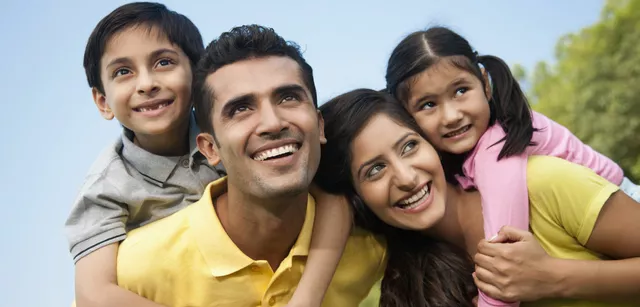Exploring the Characteristics of the Average Indian
India is home to a population of over 1.35 billion people, making it the second largest country in the world. With so many diverse ethnicities, languages, cultures, and religions, it can be difficult to determine who the average Indian is. However, there are some common characteristics that can be used to paint a picture of the average Indian.
Demographics
The average Indian is a male, aged 25 to 34, and living in an urban area. Over two-thirds of India’s population is below the age of 35, making it a nation of young people. Most of the population resides in rural areas, with only 31% living in urban centers. Additionally, the majority of the population is Hindu, but there are also small numbers of Muslims, Christians, Sikhs, Buddhists, and Jains.
Education
Education is highly valued in India, with most of the population receiving at least some level of formal education. The average Indian has completed at least 12 years of schooling, with a significant number completing higher education. Over one-third of the population has completed a college degree, and the literacy rate is increasing steadily.
Employment
The average Indian is employed in a white-collar profession such as a professional or managerial job. The service industry is the largest employer in India, followed by the manufacturing and construction sectors. Most of the population is employed in the informal sector, while most of the educated population works in the formal sector. Agriculture is still the backbone of the economy, but the proportion of the population employed in the sector has been decreasing steadily.
Income
The average Indian earns an annual salary of around $2,200, which is significantly less than the global average. Over two-thirds of the population falls below the poverty line, and the gap between the rich and the poor is widening. The growing economy is creating more opportunities for higher-paying jobs, but the country still has a long way to go before all Indians have access to a decent standard of living.
Lifestyle
The average Indian is a family-oriented person who values tradition and culture. They enjoy spending time with their family and friends, and place a high emphasis on relationships. They are passionate about their religion and culture, and take pride in their heritage. The average Indian also enjoys spending time outdoors, and exploring the country’s rich history and culture.
Conclusion
The average Indian is a complex individual, with a unique blend of characteristics and values. They are passionate about their culture and traditions, and strive to make a better life for themselves and their families. Despite the challenges they face, they remain optimistic and determined to make India a better place.
Examining the Cultural Norms of the Average Indian
India is a culturally diverse country with a multitude of different beliefs and customs that are deeply rooted in its history. The average Indian is a complex blend of different traditions and norms, making it difficult to describe who they are. However, there are some general traits and characteristics that are seen in many Indians.
Family is a key part of Indian culture, and the average Indian typically values family bonds above all else. Indian families often live together in extended households, with multiple generations living under one roof. This allows for strong interpersonal relationships to form between family members, which is an important part of Indian culture.
Religion is also a major part of Indian culture, and the average Indian is likely to be a believer in some form of spirituality. Hindus are the largest religious group in India, and the majority of Indians have beliefs and values that are based on Hinduism. Other religions such as Islam, Christianity, Jainism, and Buddhism also have a significant presence in India.
The average Indian is also likely to be well-educated, as education is highly valued in Indian society. Indians are known to be hardworking and dedicated to their studies, and a good education is seen as a path to success in life.
While the average Indian may have some similarities in terms of beliefs and values, there are also many regional and cultural differences that can be seen between different parts of the country. These regional and cultural differences can be seen in language, food, clothing, and other aspects of everyday life.
Overall, the average Indian is a complex blend of different traditions and norms, which makes it difficult to describe who they are. However, there are some common traits and characteristics that are seen in many Indians, such as strong family bonds, religious beliefs, and a commitment to education.
Investigating the Habits and Behaviour of the Average Indian
India is a country of 1.3 billion people and is one of the most populous nations in the world. Each individual has a unique lifestyle and set of habits, but what is the average Indian like? To understand the habits and behaviour of the average Indian, it is necessary to consider both their cultural and economic circumstances.
India is a country of rich cultural diversity and the average Indian is deeply rooted in the society and culture of their respective region. They are deeply religious and religious festivals are an integral part of their lives. The average Indian household is also deeply family-oriented. This can be seen in the traditional values that are passed down from generation to generation and in the emphasis placed on respecting elders.
The economic circumstances of the average Indian has a major influence on their behaviour and habits. The majority of Indians are employed in the informal sector and are living on or below the poverty line. This affects the way they approach their day-to-day lives. The average Indian is likely to be thrifty, careful with their money, and highly focused on making ends meet.
While the average Indian may not have a great deal of disposable income, they are often highly resourceful. This can be seen in the way they use their limited resources to provide for their family and in their focus on using time and resources wisely. This resourcefulness also extends to the way they approach their work, as they are able to find creative solutions to problems without a lot of resources.
When it comes to leisure activities, the average Indian is likely to be quite traditional. This includes activities such as watching television, listening to music, and playing sports. The average Indian is also likely to be quite social, often spending time with friends and family. They may also engage in activities such as going to the movies, visiting a park, or going to a religious shrine.
The habits and behaviour of the average Indian are shaped by their culture and economic circumstances. They are often deeply religious and family-oriented and have a strong focus on resourcefulness and efficiency. When it comes to leisure activities, they often engage in traditional activities. By understanding the habits and behaviour of the average Indian, it is possible to gain insight into the unique culture and lifestyle of this vast nation.
Analysing the Lifestyle of the Average Indian
The average Indian is an interesting demographic to observe and understand. They come from a variety of backgrounds and have many different ways of living. This article will analyse the lifestyle of the average Indian and the various factors that affect their day-to-day lives.
When it comes to their dwellings, the average Indian usually lives in a house or apartment. The quality of the accommodation varies, but most homes tend to be modest in size. The majority of Indians either rent or lease their homes, although some are fortunate enough to own them.
The average Indian's diet consists of traditional food items such as curries, dals, chapatis, and other such dishes. Fruits and vegetables are also an important part of the diet, though meat is consumed much less frequently. Indians are also known for their sweet tooth and often enjoy desserts such as gulab jamun, rasmalai, and more.
In terms of clothing, the average Indian tends to dress modestly, with traditional Indian clothes such as salwar kameez and sarees being the most popular. Western clothing is becoming increasingly popular, however, especially among the younger generations.
The average Indian's lifestyle is largely determined by their religious and cultural beliefs. Hinduism is the most widely practised religion in India, but there are also many Muslims, Christians, Sikhs, Jains, and Buddhists. The overall culture of India is heavily influenced by its ancient roots, with many customs and traditions still being followed today.
Education is also an important part of the average Indian's lifestyle. Primary and secondary schooling is compulsory for all Indian children, and many go on to pursue higher education at universities and colleges. The literacy rate in India is steadily increasing, with more and more people becoming educated each year.
The average Indian's income is usually quite low, with most households earning around $200-300 a month. This can vary significantly depending on the person's occupation and location. The cost of living in India is also relatively low, with basic necessities such as food and housing being affordable for most.
Finally, the average Indian's leisure activities consist mainly of watching television, listening to music, and spending time with family and friends. Social media platforms such as Facebook and WhatsApp are also popular among Indians, allowing them to stay connected with people all over the world.
Understanding the Challenges Faced by the Average Indian
India is currently the second-most populous country in the world, and the average Indian is a person of great resilience, innovation, and ambition. However, there are also a number of challenges that a typical Indian faces every day. In order to understand these challenges, it is important to look at the key aspects of life in India.
The most obvious challenge that the average Indian faces is poverty. Despite the fact that India is one of the fastest-growing economies in the world, poverty is still rampant in many parts of the country. This poverty is especially pronounced in rural areas, where access to basic necessities such as food, water, and healthcare is often limited. In addition, there are also significant economic disparities between different regions and states, which further contributes to poverty.
Another major challenge that the average Indian faces is a lack of access to basic education. India has one of the lowest literacy rates in the world, and it is estimated that over 60 million children across the country are not enrolled in school. This lack of education has a lasting effect on the lives of many Indians, as it limits their job prospects and restricts their chances of progress.
The average Indian also faces a number of health-related challenges. India has one of the highest rates of child malnutrition and mortality in the world, and access to medical care is often limited in rural areas. In addition, India is also facing a growing obesity crisis, with over 30% of the population being overweight or obese.
Finally, the average Indian also faces a number of social and cultural challenges. India is a very diverse country, and there are often strong divisions between different castes and communities. These divisions can lead to discrimination and social exclusion, which can have a negative impact on an individual's life.
The average Indian faces a number of challenges, but they are also a resilient and ambitious people. With the right support and opportunities, they can overcome these challenges and continue to move India forward.



